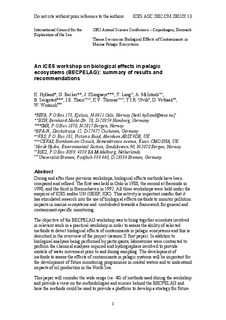| dc.contributor.author | Hylland, Ketil | |
| dc.contributor.author | Becker, Gerd | |
| dc.contributor.author | Klungsøyr, Jarle | |
| dc.contributor.author | Lang, Thomas | |
| dc.contributor.author | McIntosh, Alistair | |
| dc.contributor.author | Serigstad, Bjørn | |
| dc.contributor.author | Thain, John E. | |
| dc.contributor.author | Thomas, Kevin V. | |
| dc.contributor.author | Utvik, Toril Inga Røe | |
| dc.contributor.author | Vethaak, Dick | |
| dc.contributor.author | Wosniok, Werner | |
| dc.date.accessioned | 2012-10-30T21:24:20Z | |
| dc.date.available | 2012-10-30T21:24:20Z | |
| dc.date.issued | 2002 | |
| dc.identifier.citation | This report is not to be cited without prior reference to the authors | no_NO |
| dc.identifier.uri | http://hdl.handle.net/11250/106365 | |
| dc.description.abstract | During and after three previous workshops, biological effects methods have been compared and refined. The first was held in Oslo in 1988, the second at Bermuda in 1990, and the third in Bremerhaven in 1992. All three workshops were held under the auspices of ICES and/or UN (GEEP, IOC). This activity is important insofar that it has stimulated research into the use of biological effects methods to monitor pollution impacts in marine ecosystems and contributed towards a framework for general and contaminant-specific monitoring.
The objective of the BECPELAG workshop was to bring together scientists involved in relevant work in a practical workshop in order to assess the ability of selected methods to detect biological effects of contaminants in pelagic ecosystems and this is described in the overview of the project (session X first paper). In addition to biological analyses being performed by participants, laboratories were contracted to perform the chemical analyses required and hydrographers involved to provide models of water movement prior to and during sampling. The development of methods to assess the effects of contaminants in pelagic systems will be important for the development of future monitoring programmes in coastal waters and to understand impacts of oil production in the North Sea.
This paper will consider the wide range (ca. 40) of methods used during the workshop and provide a view on the methodologies and science behind the BECPELAG and how the methods could be used to provide a platform to develop a strategy for future monitoring and management of pelagic ecosystems. The results support an integrated
chemical and biological approach. Furthermore, the collection of wild organisms
should be supported by the use of caging due to the large variability in wild
specimens. It may be possible to recommend single methods for cost effectiveness but
added value may be achieved by using a combination of methods with little increase
in cost. The added value of using an integrated array of tools will also be presented. | no_NO |
| dc.language.iso | eng | no_NO |
| dc.publisher | ICES | no_NO |
| dc.relation.ispartofseries | ICES CM Documents;2002/X:13 | |
| dc.subject | marine ecosystems | no_NO |
| dc.subject | marine økosystemer | no_NO |
| dc.subject | monitoring | no_NO |
| dc.subject | overvåkning | no_NO |
| dc.subject | selection | no_NO |
| dc.subject | seleksjon | no_NO |
| dc.subject | development cooperation | no_NO |
| dc.subject | utviklingssamarbeid | no_NO |
| dc.subject | management advice | no_NO |
| dc.subject | forvaltningsråd | no_NO |
| dc.title | An ICES workshop on biological effects in pelagic ecosystems (BECPELAG): summary of results and recommendations | no_NO |
| dc.type | Working paper | no_NO |
| dc.subject.nsi | VDP::Mathematics and natural science: 400::Zoology and botany: 480::Marine biology: 497 | no_NO |
| dc.subject.nsi | VDP::Mathematics and natural science: 400::Geosciences: 450::Oceanography: 452 | no_NO |
| dc.subject.nsi | VDP::Social science: 200::Library and information science: 320::Knowledge retrieval and organization: 323 | no_NO |
| dc.source.pagenumber | 6 s. | no_NO |
